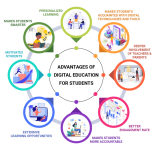Education is undergoing a rapid transformation, and digital textbooks are playing a central role in this change. As more students use tablets, laptops, and e-learning platforms, static PDFs and plain textbooks are being replaced by interactive, visually enriched learning materials. Behind this innovation lies the power of computer graphics—turning dull lessons into immersive and engaging experiences.
Whether it’s animated science diagrams, interactive geography maps, or virtual lab simulations, digital textbooks enhanced with computer graphics make complex subjects easier to understand and more enjoyable to study.
Traditional static images are being replaced by animated processes that show real-time movement. For instance, the water cycle or the functioning of a heart can be demonstrated through moving visuals. This improves concept clarity for students at all levels.
Subjects like biology, physics, and architecture benefit from 3D models of organs, machines, or buildings. Students can rotate, zoom, and explore models, developing a more hands-on learning experience without physical tools.
Clickable images and diagrams allow learners to explore parts of a concept step-by-step. For example, clicking different parts of a cell diagram reveals its function—helping students retain information better.
Some digital textbooks now support VR environments that allow students to walk through ancient cities, explore the human body from the inside, or even simulate chemical reactions safely.
Well-designed infographics turn pages of theory into concise visual summaries. These help students quickly revise and understand key concepts at a glance, making exam preparation more efficient.
The future of textbooks is undoubtedly visual and interactive. With advancements in AI, computer vision, and mixed reality, students will soon interact with their learning material in ways we can hardly imagine today—like personalized learning avatars, AI-driven visual explanations, and gesture-based navigation.
Have you ever studied with a digital textbook that used animated diagrams or 3D models?
Do you find visually enriched content more helpful than plain text?
What improvements would you like to see in educational graphics?
Let us know your thoughts in the comments!
Whether it’s animated science diagrams, interactive geography maps, or virtual lab simulations, digital textbooks enhanced with computer graphics make complex subjects easier to understand and more enjoyable to study.
The Role of Graphics in Modern Learning
1.
Traditional static images are being replaced by animated processes that show real-time movement. For instance, the water cycle or the functioning of a heart can be demonstrated through moving visuals. This improves concept clarity for students at all levels.
2.
Subjects like biology, physics, and architecture benefit from 3D models of organs, machines, or buildings. Students can rotate, zoom, and explore models, developing a more hands-on learning experience without physical tools.
3.
Clickable images and diagrams allow learners to explore parts of a concept step-by-step. For example, clicking different parts of a cell diagram reveals its function—helping students retain information better.
4.
Some digital textbooks now support VR environments that allow students to walk through ancient cities, explore the human body from the inside, or even simulate chemical reactions safely.
5.
Well-designed infographics turn pages of theory into concise visual summaries. These help students quickly revise and understand key concepts at a glance, making exam preparation more efficient.
Tools Used to Design Graphics for Digital Textbooks
- Adobe Illustrator & Photoshop: For creating high-resolution educational images.
- Blender & Maya: For 3D modeling and animations used in interactive learning tools.
- Unity & Unreal Engine: Used in VR-based textbook experiences.
- HTML5, CSS, JavaScript: For developing responsive, interactive textbook interfaces.
- Lottie & SVG animations: To include lightweight vector animations.
Educational Impact of Graphics-Based Learning
- Improves conceptual understanding through visual learning.
- Increases student engagement, especially in self-paced learning environments.
- Enhances retention and reduces boredom.
- Promotes active and inquiry-based learning.
- Helps in inclusive education for learners with language or learning barriers.
Use Cases in Global Education
- Khan Academy: Uses vector animations and simulations in science and math.
- Byju’s: Indian platform using 3D animated explanations across subjects.
- Pearson’s Interactive Textbooks: Includes clickable graphics, quizzes, and embedded videos.
- Coursera & edX: Incorporate animation and motion graphics in higher-ed content.
Limitations and Considerations
- High graphic content can make textbooks data-heavy, requiring better internet.
- Needs device compatibility, especially in rural or under-resourced areas.
- May distract from core learning if visuals aren’t well-aligned with objectives.
- Content must be accessible for students with visual impairments (via alt-text, screen reader support).
The Road Ahead
The future of textbooks is undoubtedly visual and interactive. With advancements in AI, computer vision, and mixed reality, students will soon interact with their learning material in ways we can hardly imagine today—like personalized learning avatars, AI-driven visual explanations, and gesture-based navigation.
Join the Conversation
Have you ever studied with a digital textbook that used animated diagrams or 3D models?
Do you find visually enriched content more helpful than plain text?
What improvements would you like to see in educational graphics?
Let us know your thoughts in the comments!

